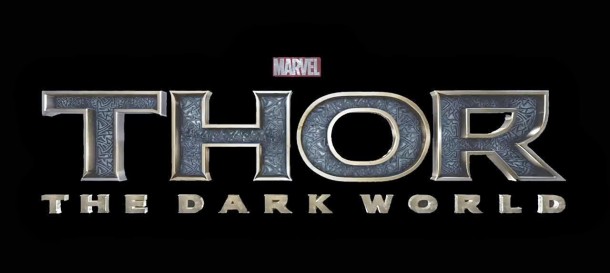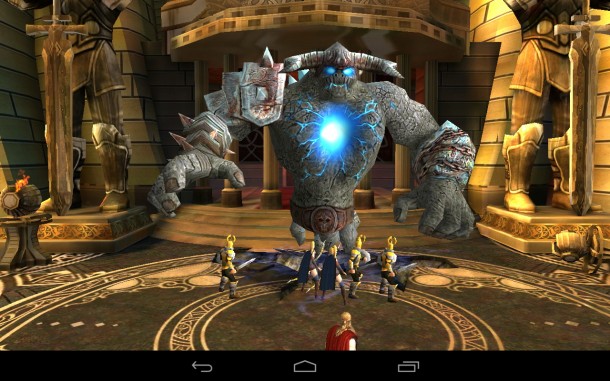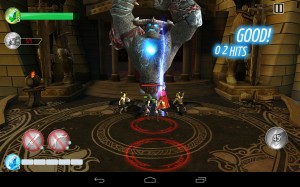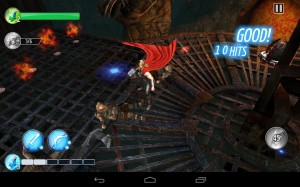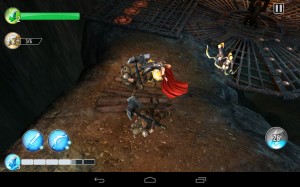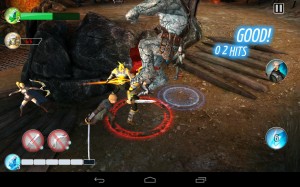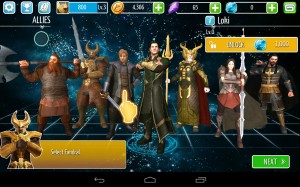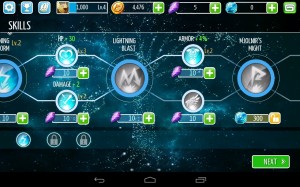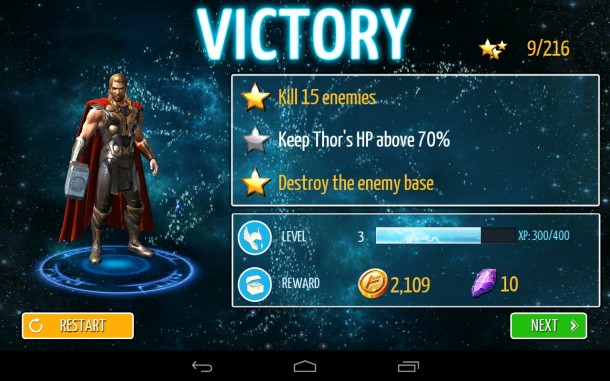When the hammer’s a-rockin’, don’t come a-knockin’. With his shimmering blonde hair, sculpted arm muscles, fine-crafted armor and chiseled jaw, it’s not hard to see why one particularly iconic Norse version of Fabio makes the ladies’ hearts twitter. But does Thor’s intimidating, yet refined image have the same wooing effect on gamers?
Weighing in at just under 2GB, Thor: The Dark World is nothing to sneeze at. In his quest to vanquish the evil Dark Elves from the Nine Worlds, Thor waves his giant shiny hammer furiously in the face of corruption. Summon the Einherjar, strap on your golden armor, pull Wolf Killer out of the shed and get ready for battle. But do so only if you have the URU to make it happen. Thor: TDW is the “official” game created to profit from the recent theatrical release of the movie, and profit it will. Being one of the more intricate games I’ve played on Android in quite some time, there are plenty of mechanics here to keep you busy. Playing as Thor, the missions themselves are brief and action packed – if not a tad simplistic and scripted. Each mission is presented as a hub along a linear path through the worlds, and preparation will make all the difference in your success or failure. Let’s focus first on the missions themselves since they’re by far the easiest to explain.
An Army At Your Fingertips
Once Thor is dumped into the scene, he’s presented with a quick cinematic that motivates him forward. At his disposal are the Einherjar – legions of soldiers available for summoning – and an ally of choice from the official roster of plot characters. Each stage is 100% linear, forcing Thor to stay on a narrow path toward the goal, and movement is accomplished by constantly tapping on a new destination. While this tap-to-move schema avoids the perils of the dreaded d-pad, the real estate presented on the screen at any given moment is so zoomed-in that tapping takes up a good portion of the action. You tap to move, tap an enemy to fight, and swipe with two fingers to throw your hammer at range.
Combat is a disappointingly simplistic, yet entertaining affair. Once tapped, Thor makes quick work of his enemy – mostly without any additional input needed from your finger. Thor has several unique moves he’ll perform with acrobatic ease, and the more fancy the moves are the more combo points he’ll accrue. You have no say in the matter, so just sit back and watch the fireworks. In fact, in any given mission your job duties are limited to selecting targets, triggering the occasional special power, and making sure your army is well staffed.
Ermagherd! Erts Ernherjer
While Thor is busy smashing face, his chosen ally and Einherjar army go to town according to their own individual preferences. As the Einherjar expire, you’ll need to take a moment to summon more so that you don’t get lonely in Nidavellir. There is a wide variety of soldiers to summon, each with its own particular strength and weakness vs. your opponents. Choosing the proper combination of Einherjar will make or break your mission so you’ll need to pay attention when told what enemies you’ll be facing. Einherjar come in a wide variety of styles, from the sexy Valkyrie archers to the hefty, armor-clad royal guard, and each type can be upgraded between missions to increase their abilities.
URU Is, Or URU Not My Baby?
The stages themselves are brief yet difficult affairs, casting Thor as the army general who jumps into the melee side-by-side with his brethren. Unless you’re willing to pony up some cash to buy URU – one of 4 types of in-game currency – you’ll often find yourself without health potions or access to the most powerful armor, weapons, and upgrades. To forego the curse of “freemiosity” that this game bestows means you’ll be repeating old missions in order to gain the currency and experience needed to make it through the current. The difficulty of some of the missions is admirable, but Thor: TDW is a game that almost makes it painful to play unless you spend some real-world cash. While flashy and complex, Thor’s mastery of the freemium bind left a terrible taste in my mouth.
Upgrade Paradise
It’s in between the combat missions where most of the complexity of Thor: TDW lies. During each stage, you’ll gather gold and gems (isotope-8) that can be used between missions to upgrade just about everything you can imagine. Each of the 7 Einherjar can be upgraded with massive amounts of gold, and those you don’t yet have access to can be unlocked using precious URU. Thor’s 8 allies follow the same mechanics, but these unique followers also come with their own special abilities during battle making them must more powerful than your soldiers. Should an ally fall, you’ll be forced with the choice of waiting several hours for them to heal… or, of course, spending some more URU to speed up the process. The story’s protagonist has the widest array of upgrade options which really make this game stand out as a well designed and complex title.
A fourth and more nebulous type of in-game currency are “stars”, gained from sheer experience and leveling. Stars unlock Thor’s more hefty armor sets while URU and meeting mission benchmarks unlocks his hammers. Both armor and hammers can be upgraded with gold. Even Thor himself can be upgraded. One final and essential component to The Dark World’s gigantic and complex upgrade system is Thor’s skill tree. Thor’s special abilities are unlocked in the skill tree interface using – you guessed it – more URU, and are upgraded using gems. Thor also has passive abilities you can upgrade such as hit points, damage, armor, and combat speed. There are 3 trees to unlock, and each tree is packed with things to unlock and master.
The Missing Worlds
With 18 mission hubs each in the starting worlds of Asgard and Nidavellir, I’m going to take a leap and say that completing all 5 worlds will make for quite a lengthy play experience. “Five worlds!?” you say, “I thought there were 9!” Your math skills are effective, young Jedi. The story and description says nine and the game interface shows five; your guess is as good as mine. I imagine the other four will either rear their heads as the game progresses (I gave up because I didn’t want to spend any money), or will be made available in some future release. Even so, the readily apparent five words will certainly give you plenty combat and min/maxing to keep you busy for quite a while. Should you grow weary of tapping your way through The Dark World’s tiny scripted missions or losing yourself in Thor’s skill tree, you can try your hand in the Arena combating waves of enemies for unique rewards.
Graphically speaking, Thor gets high marks for its shiny and colorful style. The audio is also top-notch with a sweeping soundtrack to keep you company at all times. My only complaint from the graphics department is in the cut-scenes where the characters seem to wave their arms and bob their heads totally out of sync with the dialogue. What’s more, their mouths don’t move when they talk. Minor imperfections, but still odd things to have missed during development. The graphics engine is also apparently pretty taxing on my 1st gen Nexus 7 tablet, resulting in frequent stuttering and lag; annoying but not unplayable.
The Verdict
Thor:TDW is a deep and complex action/RPG that costs you not a penny to download, but a very pretty penny to excel at. Gameloft makes quality titles, and Thor is no exception. From the graphics and sound to its complex skill and upgrade systems, The Dark World will keep you entertained for a good long time. Unfortunately, to play this game without forking over some cash will be taxing on your patience. Thor is quite possibly one of the most irritatingly effective Android games to-date when it comes to balancing the fine line of entertainment and demand for your money. Still, it really is an excellent game that warrants a dabble, even if you almost immediately get frustrated by what it doesn’t let you do.
+ Deep skill and upgrade mechanics
+ Gorgeous graphics
+ Plenty of missions to keep you busy
– Shallow and brief combat sequences
– Very difficult to progress without purchasing content
– “Bobble head” dialogue sequences
